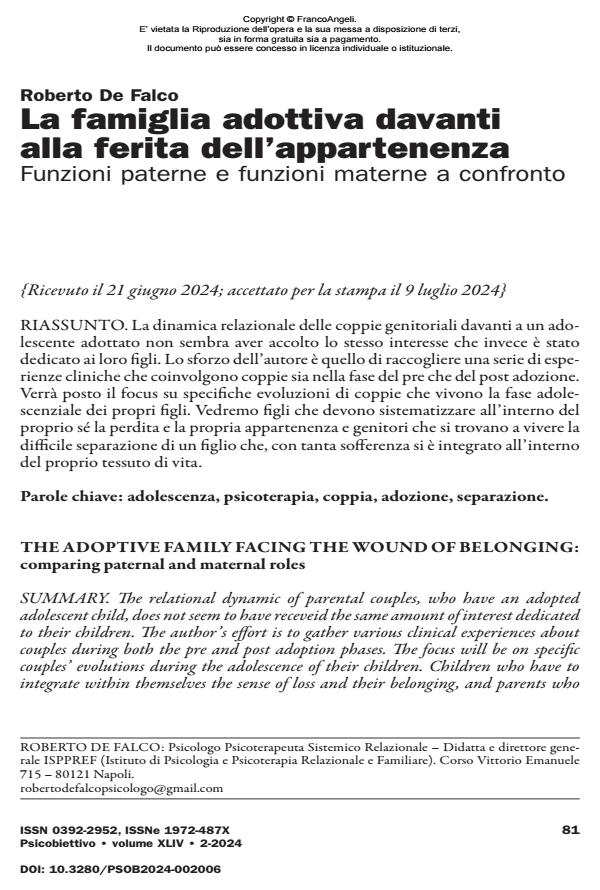The adoptive family facing the wound of belonging: comparing paternal and maternal roles
Journal title PSICOBIETTIVO
Author/s Roberto De Falco
Publishing Year 2024 Issue 2024/2
Language Italian Pages 14 P. 81-94 File size 667 KB
DOI 10.3280/PSOB2024-002006
DOI is like a bar code for intellectual property: to have more infomation
click here
Below, you can see the article first page
If you want to buy this article in PDF format, you can do it, following the instructions to buy download credits

FrancoAngeli is member of Publishers International Linking Association, Inc (PILA), a not-for-profit association which run the CrossRef service enabling links to and from online scholarly content.
The relational dynamic of parental couples, who have an adopted adolescent child, does not seem to have receveid the same amount of interest dedicated to their children. The author’s effort is to gather various clinical experiences about couples during both the pre and post adoption phases. The focus will be on specific couples’ evolutions during the adolescence of their children. Children who have to integrate within themselves the sense of loss and their belonging, and parents who live the difficult separation from a child who, with so much suffering, has integrated into their own life’s tissue.
Keywords: adolescence, psychotherapy, couple, adoption, separation
- Attili G. (2017). Il ruolo del padre e l’evoluzione della paternità. Terapia Familiare, 113: 39-51. DOI: 10.3280/TF2017-113003
- Bateman A., Fonagy P. (2012). Handbook of Mentalizing in Mental Health Practice. American Psychiatric Publishing (trad. it.: Mentalizzazione e disturbi di personalità. Una guida pratica al trattamento. Milano: Raffaello Cortina Editore, 2016).
- Bowlby J. (1965). Child Care and the Growth of Love. Penguin Books (trad. it.: Una base sicura. Applicazioni cliniche della teoria dell’attaccamento. Milano: Raffaello Cortina Editore, 1996).
- Brodzinsky D., Gunnar M., Palacios J. (2022). Adoption and trauma: Risks, recovery, and the lived experience of adoption. Child Abuse & Neglect, 130(Pt 2): 105309.
- Fadiga L. (2003). L’adozione. Una famiglia per chi non ce l’ha, II ed. Bologna: il Mulino.
- Pace C.S., Muzi S. (2017). Adolescenza in famiglie adottive e biologiche: sintomi psicopatologici e strategie di regolazione emotiva. Giornale italiano di psicologia, 44(3): 783-791. DOI: 10.1421/88386
- Pannor R., Baran A., Sorosky A.D. (1978). Birth parents who relinquished babies for adoption revisited. Family Process, 17(3): 329-337.
- Spano A., Fava Vizziello G. (2004). C’era una volta un padre: i padri adottivi raccontano. In: Fava Vizziello G., Simonelli A. (a cura di). Adozione e cambiamento. Torino: Bollati Boringhieri.
- Spitz R.A. (1965). The first year of life; a psychoanalytic study of normal and deviant development of object relations. Madison: International Universities Press (trad. it.: Il primo anno di vita del bambino. Milano: Feltrinelli, 1969).
- Valdilonga F. (2009). Curare l’adozione. Modelli di sostegno e di presa in carico dei percorsi adottivi. Milano: Raffaello Cortina Editore.
- Whitaker C.A. (1989). Midnight Musings of a Family Therapist. New York: Norton & Company (trad. it.: Considerazioni notturne di un terapeuta della famiglia. Roma: Astrolabio-Ubaldini, 1990).
- Winnicott D.W. (1965). Developmental Psychology and Environmental Studies. London: Hogarth Press (trad. it.: Sviluppo affettivo e ambiente. Studi sulla teoria dello sviluppo affettivo. Roma: Armando, 2000).
Roberto De Falco, La famiglia adottiva davanti alla ferita dell’appartenenza Funzioni paterne e funzioni materne a confronto in "PSICOBIETTIVO" 2/2024, pp 81-94, DOI: 10.3280/PSOB2024-002006